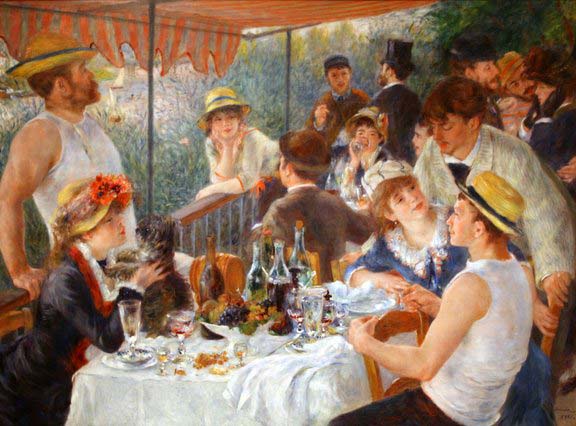| Le déjeuner des Canotiers | |
|---|---|
 |
|
| Artist | Pierre-Auguste Renoir |
| Year | 1880–1881 |
| Medium | Oil on canvas |
| Location | The Phillips Collection, Washington, DC |
| Dimensions | 51 in × 68 in |
| 129.9 cm × 172.7 cm | |
| Famous Paintings by Renoir | |
| Le déjeuner des Canotiers | |
| Bal du moulin de la Galette | |
| La Grenouillère | |
| The Swing (La Balançoire) | |
| Two Sisters (On the Terrace) | |
| Two Young Girls at the Piano | |
| A Girl with a Watering Can | |
| Dance in the Country | |
| By the Seashore |
Le déjeuner des Canotiers is a painting by the French impressionist, Pierre Auguste Renoir. It was completed in 1881 and is presently a part of the Phillips Collection in Washington D.C. Its name translates into English as “Luncheon of the Boating Party.”
The painting is a representation of a group dining on a balcony at the Restaurant Fournaise, overlooking the Seine, in the town of Chatou near Paris. The restaurant was a favorite haunt of the artist and features in several other of his works.
Le déjeuner des Canotiers is an excellent example of the artist’s mastery of color and light. As in many of Renoir’s paintings, the composition includes several people who were friends of the artist.
People in the painting
In the bottom right foreground, wearing a boater hat, is Gustave Caillebotte who was himself a painter and an important patron of the arts. Seated beside Caillebotte is Angèle Legault, a popular actress of the period, and the journalist, Adrien Maggiolo is leaning over her. Opposite Caillebotte and holding a small dog is Aline Charigo, a seamstress whom Renoir eventually married.
To the upper right of the painting is another actress, Jeanne Samary. In the center of the artwork is Ellen Andree, yet another actress, who is depicted holding a drinking glass to her mouth. She is seated opposite Baron Raoul Barbier. Also depicted is Charles Ephrussi who was the editor of the Gazette des Beaux-Arts, an important reference review on world art history.
Controversy
Despite the beauty of the painting, Le déjeuner des Canotiers did not always enjoy pride of place in the Phillips Collection. Time magazine’s art critic, Alexander Eliot, was dismayed to find the painting had been moved to a badly lit room.
When he protested, he learned that the painting had been sent to a restoration firm to remove a small blister. The restorers, without consulting Phillips, decided to undertake a complete cleaning, which many experts believe ruined the painting.